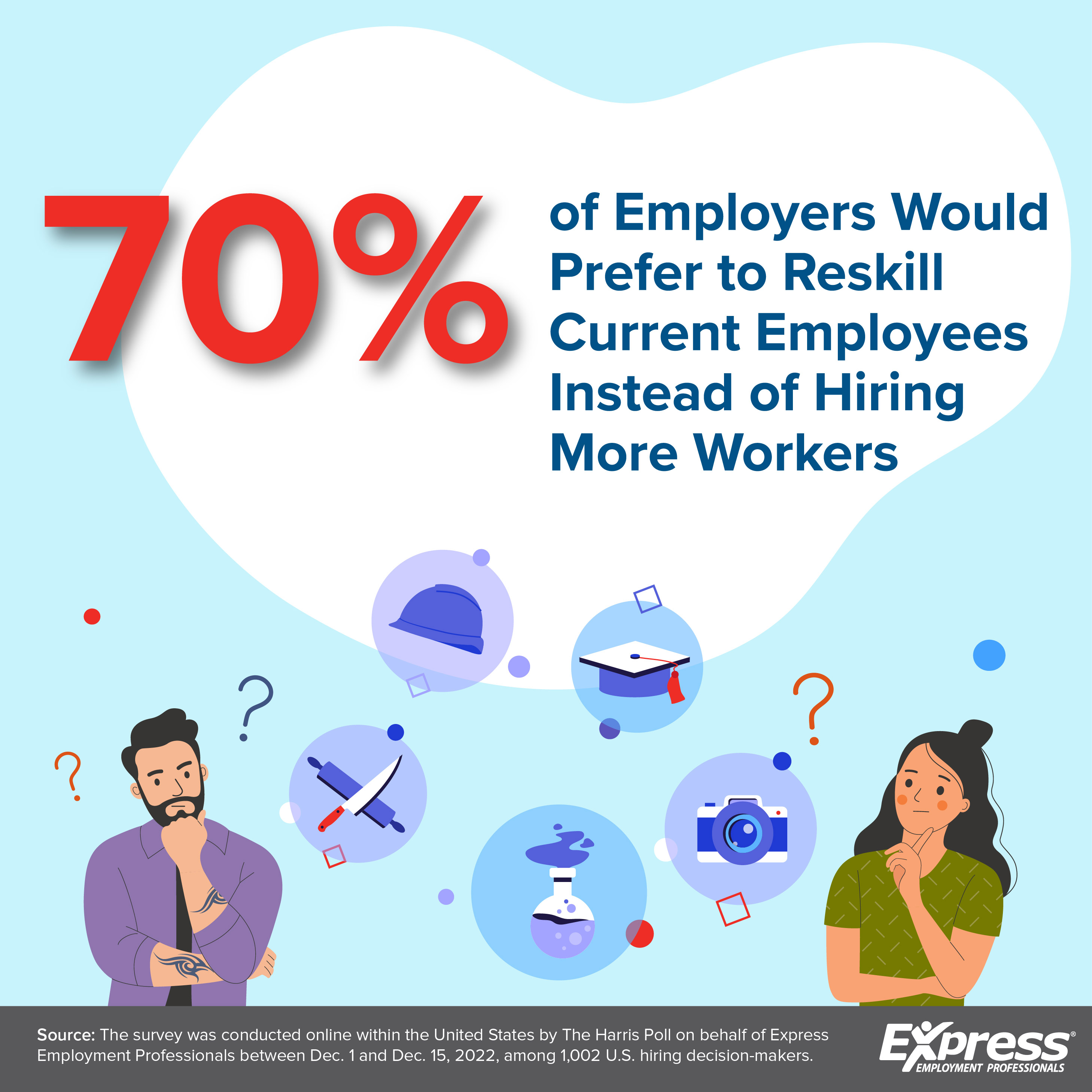Companies on the hunt for new talent are turning to reskilling as a viable solution to labor and skills shortages as 70% of hiring managers say they would prefer to train their current employees for different roles before bringing on new workers, according to a survey from The Harris Poll commissioned by Express Employment Professionals.

The preference to reskill workers has dropped back to a level last seen in 2021 (77% in the first half of 2022, 75% in the second half of 2021 and 72% in the first half of 2021) but continues to be supported by the majority of hiring managers.
However, when it comes to the question of who is responsible for finding, providing and/or paying for these trainings, surprisingly, U.S. hiring managers and employed Americans agree employers should be responsible for providing and paying for trainings, upskilling and/or reskilling for employees (78% each).
Nearly 9 in 10 hiring managers (89%) report their companies provide and/or pay for trainings—54% of whom both provide and pay for them. Although, if an employee were to leave the company within a year after starting a training program that the company paid for, more than half of hiring managers (55%) agree the employee should then be required to reimburse the company.
Short-Term Solutions
“The role of training is paramount to solving the labor shortage because it’s more of a skills gap right now versus shortage of labor,” according to Mike Nolfo, a New Jersey Express franchise owner. “Interviews have increased more than 50% this year, but there is a major gap between applicants’ skill sets and what is required from client companies. Either clients have to embrace the upskilling of new hires or new employees must start taking personal steps to fill in their knowledge gaps.”
The labor shortage is more apparent in Wisconsin where Express franchise owner Matt Sullivan adds that challenges in his market are compounded by not only “‘qualified workers’ in short supply, but the ‘quantity of any worker’ is in short supply.”
“The vast number of available jobs can be learned quickly, are not complex and do not require significant experience,” he said. “For those positions, companies need to throw out their outdated screening approach.”
Sullivan also suggests that companies could fill vacancies faster, and possibly with more success, if they adopt a “working interview” approach.
“A working interview allows both the candidate and company to start working together almost immediately,” he said. “Working interviews help the company see what the candidate can do and also allow the candidate to determine if the work is what they are seeking.”
Training Responsibility and Payment
In line with the survey results from The Harris Poll, Sullivan agrees that while both employees and companies bear responsibility for training on necessary skills, the responsibility of job-specific training falls on the employer.
“When an employer is requiring a specific skill set or knowledge base, they should be willing to take on the burden of providing that training,” he added. “That said, employers will look more fondly at candidates who already possess the required skill set. Smart candidates acquire skills and a knowledge base and leverage those throughout their career.”
For Nolfo, the worker/employer relationship is crucial to overcoming the labor shortage, therefore employers need to spend the money on training and workers should commit to companies willing to train them.
“This is a two-way street, but initially, I think companies should invest in their people and pay for the training,” he said. “Every company and job is different—there is no perfect employee. However, this will give companies the ability to build their workforce from scratch versus inheriting employees with varied skill sets.”
Because building that qualified workforce takes time, Nolfo suggests stepping back job opening requirements in the meantime.
“Hire for the basics, and train on the rest,” he said. “That will help with filling the jobs, knowing that it may take an additional 3-6 months of training to get someone up to speed. Right now, most employees are impatient with new hires, and patience is key. If the work ethic and culture fit is there, then we can train on the skills.”
The critical skills gap has only just begun to severely impact the workforce, and almost every industry will continue to suffer if there isn’t a turning point soon, according to Express Employment International CEO Bill Stoller.
“This isn’t an issue that will be solved overnight or by one person,” he added. “Young people need to be educated on the lucrative careers in skilled trades, and the government should provide incentives for these careers. Whether the onus of training ultimately falls on the worker or employer, action needs to be taken now on both sides to ensure the stable and balanced workforce of the future.”

No comments yet.